
Welcome to Hyperion Records, a British classical label devoted to presenting high-quality recordings of music of all styles and from all periods from the twelfth century to the twenty-first.
Hyperion offers both CDs, and downloads in a number of formats. The site is also available in several languages.
Please use the dropdown buttons to set your preferred options, or use the checkbox to accept the defaults.

The opening ‘In der Fremde’ is typical in its expression of estrangement and nostalgia amid a dark, woodland landscape. Schumann’s tune has a haunting pathos, discreetly heightened by its gently rippling arpeggio accompaniment. The German forest is at its most sinister in ‘Waldesgespräch’ (No 3), a variation on the Lorelei myth, with its dramatically timed moment of recognition and ironically echoing hunting-horns (dying away eerily in the piano postlude), and again in ‘Zwielicht’ (No 10). Here the keyboard part coils around the voice like a tortuous Bach three-part invention, with an oppressive chromaticism that threatens to dissolve familiar tonal outlines. ‘Auf einer Burg’ evokes a mysterious antiquity with its gloomy, incantatory vocal line, modal harmonies and solemn touches of canonic imitation. In the penultimate song, ‘Im Walde’, the wedding and the hunt, evoked as if through a gauze in Schumann’s music, suddenly fade, leaving only the sighing forest and the poet’s nameless fears amid the darkening inner and outer landscapes.
At the other end of the spectrum, ‘Intermezzo’ (No 2) is an increasingly impassioned avowal of love to Clara, growing from a falling five-note figure Schumann often associated with her. ‘Die Stille’ is a more secretive—and feminine—confession (the German title means both ‘stillness’ and ‘the silent girl’), with a sudden soaring at ‘Ich wünscht’, ich wär’ ein Vöglein’. ‘Schöne Fremde’ (No 6) and ‘Frühlingsnacht’(No 12), with its evanescent wisps of countermelody and triumphant final ‘sie ist Dein!’, are shimmering visions of physical and spiritual elation, while ‘Mondnacht’ (No 5) is perhaps the world’s loveliest vocal nocturne. Here Schumann magically delays the resolution on to the tonic chord until ‘Die Erde’ in bar ten, the moment of mystical-erotic union between sky and earth, Robert and Clara.
from notes by Richard Wigmore © 2012
L’«In der Fremde» inaugural dit typiquement l’éloignement et la nostalgie au cœur d’un sombre paysage boisé. La mélodie schumannienne véhicule un pathos lancinant, que rehausse discrètement l’accompagnement d’arpèges doucement ondoyants. La forêt allemande se montre sinistre entre toutes dans «Waldesgespräch» (nº 3), une variation sur le mythe de la Lorelei—avec son moment théâtral de la reconnaissance, et avec ses cors de chasse qui font un écho ironique (s’effilochant sinistrement dans le postlude pianistique)—, et dans «Zwielicht» (nº 10). Ici, la partie de clavier s’enroule autour de la voix telle une tortueuse invention à trois parties bachienne, avec un chromatisme oppressant qui menace de dissoudre les contours tonals familiers. Avec sa ligne vocale lugubre, incantatoire, ses harmonies modales et ses solennelles touches d’imitation canonique, «Auf einer Burg» évoque une mystérieuse antiquité. Dans l’avant-dernier lied, «Im Walde», le mariage et la chasse, comme suggérés à travers une gaze dans la musique de Schumann, s’évanouissent brusquement pour ne laisser que la forêt soupirante et les peurs indicibles du poète dans les paysages qui s’obscurcissent, en lui comme au-dehors.
À l’autre bout du spectre, «Intermezzo» (nº 2) voit Schumann avouer à Clara son amour toujours plus fervent, à partir d’une figure de cinq notes descendantes souvent associée à la jeune femme. «Die Stille» est une confession plus secrète—et féminine (le titre allemand signifie ensemble «la quiétude» et «la jeune fille silencieuse»)—, avec une brusque envolée à «Ich wünscht’, ich wär’ ein Vöglein». Tout comme «Schöne Fremde» (nº 6), «Frühlingsnacht» (nº 12) offre, avec ses évanescents brins de contre-thème et son triomphant «sie ist Dein!» final, une vision scintillante de l’extase physique et spirituelle, cependant que «Mondnacht» (nº 5) est peut-être le plus ravissant nocturne vocal qui soit au monde. Ici, Schumann retarde magiquement la résolution sur l’accord de tonique jusqu’à «Die Erde» (mesure 10), moment d’union mystico-érotique entre le ciel et la terre, entre Robert et Clara.
extrait des notes rédigées par Richard Wigmore © 2012
Français: Hypérion
Das erste Lied, „In der Fremde“, hat einen typischen Ausdruck der Entfremdung und Nostalgie inmitten einer dunklen Waldlandschaft. Schumanns Melodie besitzt ein eindringliches Pathos, das durch die sich sanft kräuselnde Arpeggio-Begleitung noch diskret verstärkt wird. In „Waldesgespräch“ (Nr. 3) und „Zwielicht“ (Nr. 10) tritt der deutsche Wald am unheilvollsten in Erscheinung. Beim Ersteren handelt es sich um eine Variation der Loreley-Sage, in der ein dramatischer Erkennungsmoment vorkommt und ironisch nachklingende Jagdhörner auftreten, die im Klavier-Nachspiel in unheimlicher Weise ersterben. In „Zwielicht“ windet sich der Klavierpart um die Singstimme wie eine lange, dreistimmige Bach-Invention, wobei die beklemmende Chromatik die vertrauten tonalen Umrisse aufzulösen droht. „Auf einer Burg“ stellt mit seiner düsteren, beschwörenden Vokallinie, modalen Harmonien und getragenen Anklängen kanonischer Imitation ein geheimnisvolles Altertum dar. In dem vorletzten Lied, „Im Walde“, verblassen die Hochzeit und die Jagd plötzlich, die in Schumanns Musik hinter einer Gaze stattzufinden scheinen; zurückbleiben tut nur der seufzende Wald und die namenlosen Ängste des Dichters inmitten der sich verdunkelnden inneren und äußeren Landschaft.
Am anderen Ende des Spektrums steht das „Intermezzo“ (Nr. 2), eine zunehmend leidenschaftliche Liebeserklärung an Clara, die aus einer fallenden Fünfton-Figur entsteht, die Schumann oft mit ihr in Verbindung brachte. „Die Stille“ ist ein eher geheimnisvolles—und feminines—Bekenntnis, wobei die Musik bei „Ich wünscht’, ich wär’ ein Vöglein“ plötzlich emporschnellt. „Schöne Fremde“ (Nr. 6) und „Frühlingsnacht“ (Nr. 12) mit seinen dahinschwindenden Anklängen einer Gegenmelodie und triumphierenden Schlussworten „sie ist Dein!“ sind schillernde Visionen physischer und geistiger Erhebung, während „Mondnacht“ (Nr. 5) das vielleicht schönste vokale Nocturne überhaupt ist. Hier zögert Schumann die Auflösung zur Tonika zauberhaft bis zu den Worten „Die Erde“ im 10. Takt hinaus, dem Moment der mystisch-erotischen Vereinigung zwischen Himmel und Erde, Robert und Clara.
aus dem Begleittext von Richard Wigmore © 2012
Deutsch: Viola Scheffel
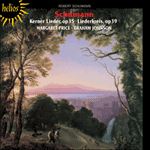 Schumann: Kerner Lieder & Liederkreis Schumann: Kerner Lieder & Liederkreis‘An outstanding Helios CD … singing and playing of the highest order’ (Gramophone) ‘A superb Schumann disc’ (The Penguin Guide to Compact Discs)» More |
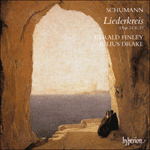 Schumann: Liederkreis Opp 24 & 39 Schumann: Liederkreis Opp 24 & 39The award-winning partnership of Gerald Finley and Julius Drake returns to Schumann with performances of the two contrasting Liederkreis (‘song-circle’) cycles to texts by Heine and Eichendorff. Also included are the Sechs Gedichte aus dem Liederb ...» More |
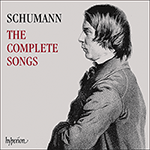 Schumann: The Complete Songs Schumann: The Complete SongsSchumann’s songs are among the greatest musical achievements of the nineteeth century, and this marvellous collection comprises Schumann’s complete songs, presented for the first time in their chronological sequence of composition, with complete s ...» More |
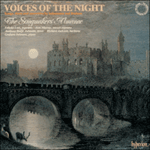 Brahms & Schumann: Voices of the Night Brahms & Schumann: Voices of the Night‘A very special experience’ (The Daily Telegraph) ‘Immaculate … delicious’ (Hi-Fi News)» More |
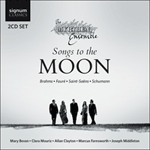 Songs to the moon Songs to the moonThe phenomenal Myrthen Ensemble—Mary Bevan, Clara Mouriz, Allan Clayton, Marcus Farnsworth and Joseph Middleton—in what is incredibly its debut recording.» More |
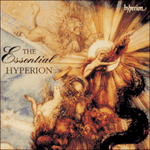 The Essential Hyperion, Vol. 1 The Essential Hyperion, Vol. 1'You'll be discovering what a superb label Hyperion is' (The Modern Dance)» More |

